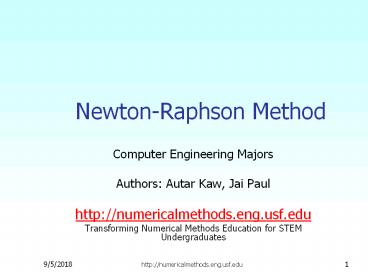Newton-Raphson%20Method - PowerPoint PPT Presentation
Title:
Newton-Raphson%20Method
Description:
To find the inverse of a number a', one can use the equation. where x is the inverse of a' ... Requires only one guess. http://numericalmethods.eng.usf.edu. 15 ... – PowerPoint PPT presentation
Number of Views:679
Avg rating:3.0/5.0
Title: Newton-Raphson%20Method
1
Newton-Raphson Method
- Computer Engineering Majors
- Authors Autar Kaw, Jai Paul
- http//numericalmethods.eng.usf.edu
- Transforming Numerical Methods Education for STEM
Undergraduates
2
Newton-Raphson Method http//numericalmetho
ds.eng.usf.edu
3
Newton-Raphson Method
Figure 1 Geometrical illustration of the
Newton-Raphson method.
http//numericalmethods.eng.usf.edu
3
4
Derivation
Figure 2 Derivation of the Newton-Raphson method.
http//numericalmethods.eng.usf.edu
5
Algorithm for Newton-Raphson Method
http//numericalmethods.eng.usf.edu
6
Step 1
- Evaluate
symbolically.
http//numericalmethods.eng.usf.edu
6
7
Step 2
Use an initial guess of the root, , to
estimate the new value of the root, , as
http//numericalmethods.eng.usf.edu
7
8
Step 3
Find the absolute relative approximate error
as
http//numericalmethods.eng.usf.edu
8
9
Step 4
- Compare the absolute relative approximate error
with the pre-specified relative error tolerance
. - Also, check if the number of iterations has
exceeded the maximum number of iterations
allowed. If so, one needs to terminate the
algorithm and notify the user.
Go to Step 2 using new estimate of the root.
Yes
Is ?
No
Stop the algorithm
http//numericalmethods.eng.usf.edu
9
10
Example 1
- To find the inverse of a number a, one can use
the equation
where x is the inverse of a.
- Use the Newton-Raphson method of finding roots of
equations to - Find the inverse of a 2.5. Conduct three
iterations to estimate the root of the above
equation. - Find the absolute relative approximate error at
the end of each iteration, and - The number of significant digits at least correct
at the end of each iteration.
11
Example 1 Cont.
Solution
Figure 3 Graph of the function f(x).
12
Example 1 Cont.
Initial guess Iteration 1 The estimate of the
root is
The absolute relative approximate error is
The number of significant digits at least correct
is 0.
Figure 4 Graph of the estimated root after
Iteration 1.
13
Example 1 Cont.
Iteration 2 The estimate of the root is
The absolute relative approximate error is
The number of significant digits at least correct
is 0.
Figure 5 Graph of the estimated root after
Iteration 2.
14
Example 1 Cont.
Iteration 3 The estimate of the root is
The absolute relative approximate error is
The number of significant digits at least correct
is 2.
Figure 6 Graph of the estimated root after
Iteration 3.
15
Advantages and Drawbacks of Newton Raphson
Methodhttp//numericalmethods.eng.usf.edu
16
Advantages
- Converges fast (quadratic convergence), if it
converges. - Requires only one guess
17
Drawbacks
- Divergence at inflection points
- Selection of the initial guess or an iteration
value of the root that is close to the inflection
point of the function may start diverging
away from the root in ther Newton-Raphson method. - For example, to find the root of the equation
. - The Newton-Raphson method reduces to
. - Table 1 shows the iterated values of the root of
the equation. - The root starts to diverge at Iteration 6 because
the previous estimate of 0.92589 is close to the
inflection point of . - Eventually after 12 more iterations the root
converges to the exact value of
18
Drawbacks Inflection Points
Table 1 Divergence near inflection point.
Iteration Number xi
0 5.0000
1 3.6560
2 2.7465
3 2.1084
4 1.6000
5 0.92589
6 -30.119
7 -19.746
18 0.2000
Figure 8 Divergence at inflection point for
19
Drawbacks Division by Zero
- Division by zero
- For the equation
- the Newton-Raphson method reduces to
- For , the denominator
will equal zero.
Figure 9 Pitfall of division by zero or near a
zero number
20
Drawbacks Oscillations near local maximum and
minimum
3. Oscillations near local maximum and minimum
Results obtained from the Newton-Raphson method
may oscillate about the local maximum or minimum
without converging on a root but converging on
the local maximum or minimum. Eventually, it
may lead to division by a number close to zero
and may diverge. For example for
the equation has no real roots.
21
Drawbacks Oscillations near local maximum and
minimum
Table 3 Oscillations near local maxima and mimima
in Newton-Raphson method.
Iteration Number
0 1 2 3 4 5 6 7 8 9 1.0000 0.5 1.75 0.30357 3.1423 1.2529 0.17166 5.7395 2.6955 0.97678 3.00 2.25 5.063 2.092 11.874 3.570 2.029 34.942 9.266 2.954 300.00 128.571 476.47 109.66 150.80 829.88 102.99 112.93 175.96
Figure 10 Oscillations around local minima
for .
22
Drawbacks Root Jumping
4. Root Jumping In some cases where the function
is oscillating and has a number of roots,
one may choose an initial guess close to a root.
However, the guesses may jump and converge to
some other root. For example Choose It
will converge to instead of
Figure 11 Root jumping from intended
location of root for .
23
Additional Resources
- For all resources on this topic such as digital
audiovisual lectures, primers, textbook chapters,
multiple-choice tests, worksheets in MATLAB,
MATHEMATICA, MathCad and MAPLE, blogs, related
physical problems, please visit - http//numericalmethods.eng.usf.edu/topics/newton_
raphson.html
24
- THE END
- http//numericalmethods.eng.usf.edu































